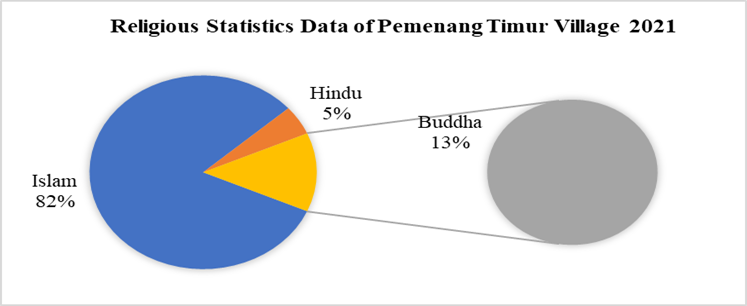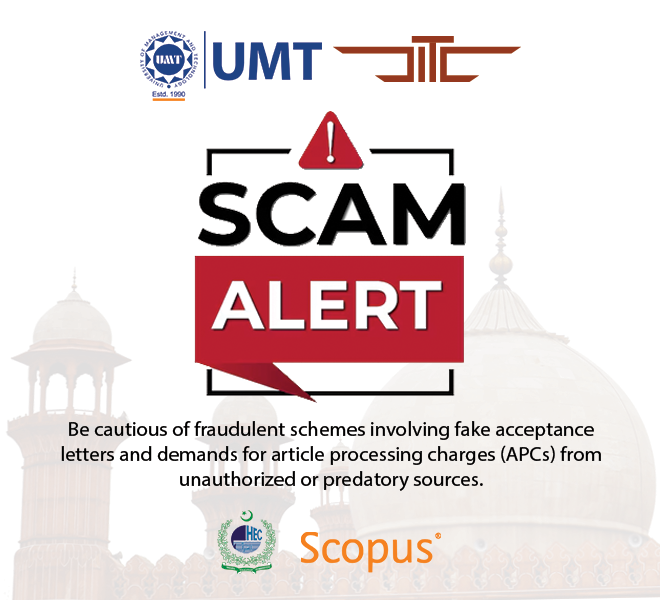Harmony in Diversity: Exploring Religiosity Cohesion Among Muslim, Hindu, and Buddhist Communities in North Lombok, Indonesia
Abstract
 Abstract Views: 0
Abstract Views: 0
This research explores social cohesion among Muslim, Buddhist, and Hindu communities in Pemenang Timur Village in Lombok, East Indonesia. This village stands out because its people peacefully coexist in close proximity among three religious groups. This is in contrast to discrimination and violence that often occur in interfaith relations in other regions in Indonesia. This research employs a qualitative method with an ethnographic approach to analyze social practices and to reveal meaningful insights. It involves in-depth interviews with religious leaders (Muslim, Hindu, and Buddhist), traditional leaders, Pemangku, and local community members. The findings show that social cohesion manifests in three forms: hereditary values characterized by blood relation through interfaith marriage, local wisdom in The Ngejot tradition held by sharing food during religious ceremonies, and religious cohesion represented by concepts such as Tasamuh concept in the Islam, Tri Hita Karana in Hinduism and the Vihara Brahma in Buddhism. Through these religious cohesion values, the social heritage and local traditions are preserved to maintain harmony between religious communities and foster mutual respect as part of civic culture, and to improve social solidarity between religious communities. They play a vital role in cultivating unity and integrity among different religions and ethnicities. The findings of this research emphasize the importance of social cohesion in building harmony between religious communities in other regions of Indonesia, contributing to more peaceful, and harmonious nations with respect for diverse religious beliefs, ethnicities, cultures, tribes, and languages.
Downloads
References
Budiwanti, Erni., and Levi Geir Eidhamar. “Religious Diversity in Lombok: Peaceful Coexistence or Minorities at Risk?” Religions 15 (2024): 1544. https://doi.org/https://doi.org/10.3390/rel15121544.
Cook, Joseph. Heredity. Norderstedt, Germany: Outlook Verlag, 2023.
Crespin-Boucaud, Juliette. “Interethnic and Interfaith Marriages in Sub-Saharan Africa.” World Development 125 (January 1, 2020): 104668. https://doi.org/10.1016/J.WORLDDEV.2019.104668.
Creswell, John W. Qualitative Inquiry and Research Design: Choosing among Five Traditions. SAGE, 2007.
Delhey, Jan, Georgi Dragolov, and Klaus Boehnke. “Social Cohesion in International Comparison: A Review of Key Measures and Findings.” Kolner Zeitschrift Fur Soziologie Und Sozialpsychologie 75 (July 1, 2022): 95–120. https://doi.org/10.1007/s11577-023-00891-6.
Diab, Ashadi L., Mustaqim Pabbajah, Ratri Nurina Widyanti, Lian Mulyani Muthalib, and Widi Fajar Widyatmoko. “Accommodation of Local Wisdom in Conflict Resolution of Indonesia’s Urban Society.” Cogent Social Sciences 8, no. 1 (2022):1-14, https://doi.org/10.1080/23311886.2022.2153413.
Douglas, Gavin D. “Metta, Mudita, and Metal: Dhamma Instruments in Burmese Buddhism.” Yale Journal of Music & Religion 6, no. 1 (2020): 1–18. https://doi.org/10.17132/2377-231X.1159.
Elmali-Karakaya, Ayse. “Interfaith Marriage in Islam: Classical Islamic Resources and Contemporary Debates on Muslim Women’s Interfaith Marriages.” Religion, no. 13 (2022): 1–21.
Ermiana, Ida., I Made Sutajaya, I Wayan Suja, and Asri Fauzi. “Meta-Synthesis: Tri Hita Karana a Philosophy of Harness and Life Harmony.” Progres Pendidikan 4, no. 2 (2023): 109–16. https://doi.org/10.29303/PROSPEK.V4I2.348.
Fonseca, Xavier., Stephan Lukosch, and Frances Brazier. “Social Cohesion Revisited: A New Definition and How to Characterize It.” Innovation: The European Journal of Social Science Research 32, no. 2 (April 3, 2019): 231–53. https://doi.org/10.1080/13511610.2018.1497480.
Forrest, Ray, and Ade Kearns. “Social Cohesion, Social Capital and the Neighbourhood.” Http://Dx.Doi.Org/10.1080/00420980120087081 38, no. 12 (November 1, 2001): 2125–43. https://doi.org/10.1080/00420980120087081.
Gede Agung, Dewa Agung., Ahmad Munjin Nasih, Sumarmi, Idris, and Bayu Kurniawan. “Local Wisdom as a Model of Interfaith Communication in Creating Religious Harmony in Indonesia.” Social Sciences & Humanities Open 9 (January 1, 2024): 100827. https://doi.org/10.1016/J.SSAHO.2024.100827.
Hakim, Herdiana. “Seeking ‘Unity in Diversity’: Contemporary Children’s Books in Indonesia.” Asian Children’s Literature and Film in a Global Age (2020): 245–87. https://doi.org/10.1007/978-981-15-2631-2_12.
Hamdi, Saipul., and Bianca J. Smith. “Sisters, Militias and Islam in Conflict: Questioning ‘reconciliation’ in Nahdlatul Wathan, Lombok, Indonesia.” Contemporary Islam 6, no. 1 (2012): 29–43. https://doi.org/10.1007/S11562-011-0168-5/METRICS.
Hillenbrand, Carolin. “Religion, a Bridge or Barrier in Society?” Religiosity in East and West (2020): 19–41. https://doi.org/10.1007/978-3-658-31035-6_2.
Imam, Muhayat., and Nazar Naamy. “Implementation of Tasamuh Concept in a Sociological Perspective in Multicultural Society.” Al-Hayat: Journal of Islamic Education, no. 7 (2023). https://doi.org/https://doi.org/10.35723/ajie.v7i1.390.
Kwa, Kiem-Kiok, and Samuel Ka-Chieng Law. Missions in Southeast Asia: Diversity and Unity in God’s Design. Langham Publishing, 2022.
Lombardo, Paul A. “The Power of Heredity and the Relevance of Eugenic History.” Genetics in Medicine 20, no. 11 (November 1, 2018): 1305–11. https://doi.org/10.1038/S41436-018-0123-4.
Maćkowiak, Anna M. “Conceptual Dilemmas from a Fieldwork in Indonesia: ‘Religious’ ‘Unity in Diversity’ at the Lingsar Temple Festival.” Religion 52, no. 1 (2022): 86–101. https://doi.org/10.1080/0048721X.2021.2011083.
Mandala, Ican., and Luqyana Azmiya Putri. “Interpretation Concept of Tasamuh: Conflict Resolution in Multicultural Environment to Establishing Religious Moderation.” The Progress: Journal of Language and Ethnicity 1 (2), (2022): 63–71.
Marselinawati, Putu Sri. “The Ngejot Tradition the Ngejot Tradition Increases Religious Tolerance in Gelgel Village, Klungkung Regency, Bali.: Ngejot Tradition in Klungkung.” International Proceeding on Religion, Culture, Law, Education, And Hindu Studies (2022): 1–12.
Miles, Matthew B., A Michael Huberman, and Johnny Saldaña. Qualitative Data Analysis A Methods Sourcebook Edition. SAGE Publications, 2014.
Muchammadun, Muchammadun., Zaenudin Amrulloh, and Rahadiyand Aditya. “Re-Vitalising Locality in Indigenous Tebango Buddhism: Social and Cultural Capitals for Community Wellbeing.” Jurnal Studi Sosial Keagamaan, no. 2 (August 17, 2023): 66-86. https://doi.org/10.22146/kawistara.3918.
Nardi, Bonnie A. “The Use of Ethnographic Methods in Design and Evaluation.” In Handbook of Human-Computer Interaction, 2nd ed., 361–66. Elsevier, 1997.
Nasir, Mohamad Abdun. “Conflict, Peace, and Religious Festivals: Muslim-Hindu-Christian Relations on the Eastern Indonesian Island of Lombok.” Interreligious Studies and Intercultural Theology 4, no. 1 (2022): 102–23.
—. “Religion, Law, and Identity: Contending Authorities on Interfaith Marriage in Lombok, Indonesia.” Islam and Christian-Muslim Relations 31, no. 2 (April 2, 2020): 131–50. https://doi.org/10.1080/09596410.2020.1773618.
Niekerk, Jana Van., and Maykel Verkuyten. “Interfaith Marriage Attitudes in Muslim Majority Countries: A Multilevel Approach.” International Journal for the Psychology of Religion 28, no. 4 (October 2, 2018): 257–70. https://doi.org/10.1080/10508619.2018.1517015.
Panggabean, Samsu Rizal., Rudi Harisyah Alam, and Ihsan Ali-Fauzi. “The Patterns of Religious Conflict in Indonesia (1990-2008).” Studia Islamika 17, no. 2 (2010): 239-286.
Prasetiawati, Prasetiawati. “The Role of Religious Harmony Forum for Maintain Religious Life in Palangka Raya.” Proceedings of the First International Conference on Christian and Inter Religious Studies, ICCIRS 2019, December 11-14 2019, Manado, Indonesia. EAI, 2020. http://dx.doi.org/10.4108/eai.11-12-2019.2302093.
Pratiwi, Ida Yuni., Ni Made Dwi Ratnadi, Herkulanus Bambang Suprasto, and I Ketut Sujana. “The Effect of Role Conflict, Role Ambiguity, and Role Overload in Burnout Government Internal Supervisors with Tri Hita Karana Culture as Moderation.” International Research Journal of Management, IT and Social Sciences 6, no. 3 (May 3, 2019): 61–69. https://doi.org/10.21744/irjmis.v6n3.630.
Saehu, Rahmat., and Ibnu Hasan Muchtar. “Religious Pluralism and Harmony among Buddhist-Muslim Communities Living in East Lampung, Indonesia.” Journal of Islamic Thought and Civilization 13, no. 1 (2023): 245–56.
Saparudin, Saparudin., and Emawati Emawati. “Ideological Framing, Mosques, and Conflict: Bargaining Position of Salafi Movement in Lombok, East Indonesia.” Journal of Al-Tamaddun 44, no. 1 (2023): 163–84. https://doi.org/10.2158/jid.44.1.22165.
Schulze, Kirsten E. “The ‘Ethnic’ in Indonesia’s Communal Conflicts: Violence in Ambon, Poso, and Sambas.” Affect, Interest and Political Entrepreneurs in Ethnic and Religious Conflicts, October 23, (2019): 116–34. https://doi.org/10.4324/9781351182607-6.
Setiawan, David Eko., and Kalis Stevanus. “Significance of Islam Nusantara Values in an Indonesian Multicultural Society.” Journal of Al-Tamaddun 18, no. 1 (June 19, 2023): 203–14. https://doi.org/10.22452/JAT.vol18no1.17.
Siddhi, Okkansa., Sanu Mahatthanadull, and Somboon Vuddhikaro. “A Metta-Buddhist Integrated Method for Conflict Management in The Modern Societies.” The Journal of International Association of Buddhist Universities (JIABU), no. 11 (2018): 24-48.
Somiartha, Putu., and Made Suyana Utama. “Polong Renten: In Improving the Welfare of Employees of Village Owned Business Institutions (Bumdes) in Lombok Utara Regency.” Journal of Economics, Finance and Management Studies (2021): 2582–92.
Stephen L. Schensul., Jean J Schensul, and Margaret Diane LeCompte. Essential Ethnographic Methods: Observations, Interviews, and Questionnaires. Edited by Jean J. Schensul and Margaret Diane LeCompte. California: Rowman Altamira, 2012.
Suhasti, Ermi., Siti Djazimah, and Hartini Hartini. “Polemics on Interfaith Marriage in Indonesia between Rules and Practices.” Al-Jamiah: Journal of Islamic Studies 56 no. 2 (2018): 367-394, https://doi.org/https://doi.org/10.14421/ajis.2018.562.367-394.
Summers, William C. “Heredity.” Reference Module in Life Sciences, January 1 (2022): 1–110. https://doi.org/10.1016/B978-0-12-822563-9.00011-1.
Syihab, Abdul Halim., and Asmawati Muhamad. “Reviving the Wasatiyyah Values for Inter-Religious Harmony in Plural Societies,” 2017. Journal of Al-Tamaddun, 12.2 (2017): 13-24.
Tasrif, Muh. “Upholding Faith and Religious Freedom: An Interpretation of the Qur’ānic Story of Young Cave Dwellers as a Religious Minority.” Journal of Islamic Thought and Civilization 14, no. 1 (March 1, 2024): 175–90. https://doi.org/https://doi.org/10.32350/jitc.141.11.
Ummah, Athik Hidayatul. “The Voices of Inter-Religious Harmony.” Atlantis-Press.Com (2022): 17–29.
Wilkinson, Cai. “Ethnographic Methods.” In Critical Approaches to Security, 1st ed., 17. Routledge, 2012.
Yanti, Betria Zarpina., and Doli Witro. “Self Maturity and Tasamuh as a Resolution of Religious Conflicts.” Intizar 25, no. 2 (2019): 87–94. https://doi.org/10.19109/INTIZAR.V25I2.5608.
Yuslih, Muhammad., and Ahmad Muhajir. “Portrait of Tolerance and Religious Harmony of Muslims and Hindus in Ngejot Tradition in Golong Village, West Lombok Regency.” Fenomena (2023): 135–48. https://doi.org/https://doi.org/10.35719/fenomena.v22i2.143.

Copyright (c) 2025 Suparman Jayadi

This work is licensed under a Creative Commons Attribution 4.0 International License.

This work is licensed under a Creative Commons Attribution 4.0 International License. Authors retain copyright and grant the journal right of first publication with the work simultaneously licensed under a Creative Commons Attribution (CC-BY) 4.0 License that allows others to share the work with an acknowledgement of the work’s authorship and initial publication in this journal.







